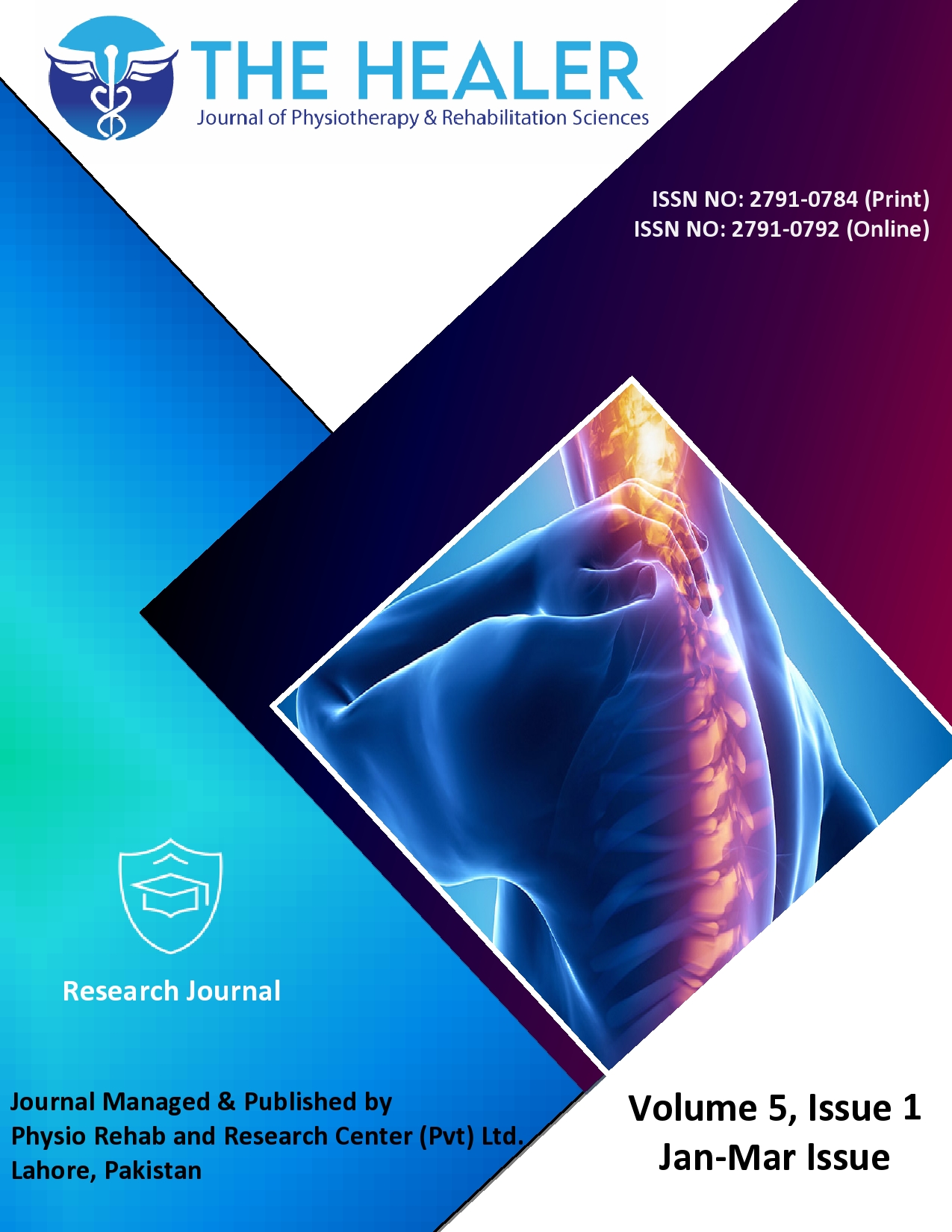Prevalence of Musculoskeletal Pain and Its Relation with Disability Risk Factors in Abbottabad Population: A Cross-Sectional Study
DOI:
https://doi.org/10.55735/xk6ddk44Keywords:
Chronic neck pain, Disability risk, Musculoskeletal pain, Neck disability indexAbstract
Background: Musculoskeletal pain is a major global health concern that affects individuals’ physical function, mental health, and quality of life. It is commonly linked with occupational strain, poor posture, and sedentary lifestyles. In developing regions like Pakistan, limited awareness and inadequate healthcare access contribute to the rising burden of musculoskeletal pain. Objective: To find the prevalence of musculoskeletal pain and its relevant disability risk in the population of Abbottabad, Khyber Pakhtunkhwa, Pakistan. Methodology: This cross-sectional study, conducted at the Women Institute of Rehabilitation Sciences Clinic, Ayub Medical College, and the Combined Military Hospital, Abbottabad, from June to November 2024. A total of 377 was estimated using the Rao-soft sample calculation; however, 362 patients aged above 18 years were recruited, using convenience sampling. Patients with a history of drug addiction, diagnosed with brain tumors, or a history of surgery, fractures were excluded. After ethical approval, consent was taken from the patient before collecting data. The questionnaire included demographic characteristics, the Neuromusculoskeletal Questionnaire for identifying pain, and the neck disability index for disability of various activities. Respondents’ descriptive data with given codes were saved in MS Excel. Inferential statistics for the non-probability sampling included association analysis using chi-square and Spearman’s correlation to find the association strength between demographic factors, pain, and disability factors. Results: Results showed that the highest number of patients in the study were females (63.5%) patients mainly housewives (29%), and belonged to middle socioeconomic status (79.8%). The most prevalent MSP was noticed for the neck (24.6%), shoulder (10.5%), and lower back (7.2%). Neck pain showed a significant (p<0.05) weak to moderate association with disability domains, whereas shoulder and elbow pain showed a significant (p<0.05) weak association with several disability domains. Conclusion: The study concluded that most patients having musculoskeletal pain had neck, shoulder, and lower back issues. Neck pain showed the highest adverse disability factors like pain, lifting, work, driving, and recreation than any other musculoskeletal disorders in the Abbottabad population. Community-based physiotherapy, stress management, and lifestyle modifications by healthcare interventions need to be implemented immediately.
Downloads
References
1. Liu S, Wang B, Fan S, Wang Y, Zhan Y, Ye D. Global burden of musculoskeletal disorders and attributable factors in 204 countries and territories: a secondary analysis of the Global Burden of Disease 2019 study. BMJ Open 2022; 12(6): e062183.
https://doi.org/10.1136/bmjopen-2022-062183
2. El-Tallawy SN, Nalamasu R, Salem GI, LeQuang JAK, Pergolizzi JV, Christo PJ. Management of musculoskeletal pain: an update with emphasis on chronic musculoskeletal pain. Pain and Therapy 2021; 10(1): 181–209.
https://doi.org/10.1007/s40122-021-00235-2
3. Alsulaihebi HS, Alsulaihebi AS, Alsaedi ZK, Alsharif SY, Mahamid AW, Babateen OM. Musculoskeletal disorder prevalence and its correlation with stress in medical students: A cross-sectional survey. Journal of Family Medicine and Primary Care 2024; 13(4): 1524–9.
https://doi.org/10.4103/jfmpc.jfmpc_1659_23
4. Conti A, Albanesi B, Clari M. Musculoskeletal disorders in healthcare workers. Current Opinion in Epidemiology and Public Health 2024; 3(1): 25–32.
https://doi.org/10.1097/PXH.0000000000000034
5. Wu A-M, Cross M, Elliott JM, et al. Global, regional, and national burden of neck pain, 1990–2020, and projections to 2050: a systematic analysis of the Global Burden of Disease Study 2021. The Lancet Rheumatology 2024; 6(3): e142–e55.
https://doi.org/10.1016/S2665-9913(23)00321-1
6. Nayab S, Kiran Q, Tariq S, et al. Effects of Elongation Longitudinaux Articular Vertebral and Columnar Decoaption Osteo Articulaire versus Upper Thoracic Mobilization on Forward Head Posture in Upper Cross Syndrome. The Healer Journal of Physiotherapy and Rehabilitation Sciences 2025; 5(2): 19-26.
https://doi.org/10.55735/hjprs.v5i2.340
7. Verdú E, Homs J, Boadas-Vaello P. Physiological changes and pathological pain associated with sedentary lifestyle-induced body systems fat accumulation and their modulation by physical exercise. International Journal of Environmental Research and Public Health 2021; 18(24): 13333.
https://doi.org/10.3390/ijerph182413333
8. Jahre H, Grotle M, Smedbråten K, Dunn KM, Øiestad BE. Risk factors for non-specific neck pain in young adults. A systematic review. BMC Musculoskeletal Disorders 2020; 21(1): 366.
https://doi.org/10.1186/s12891-020-03379-y
9. Mäkitie AA, Alabi RO, Pulkki-Råback L, et al. Psychological factors related to treatment outcomes in head and neck cancer. Advances in Therapy 2024; 41(9): 3489–519.
https://doi.org/10.1007/s12325-024-02945-3
10. Cheng S, Cao J, Hou L, et al. Temporal trends and projections in the global burden of neck pain: findings from the Global Burden of Disease Study 2019. Pain 2024; 165(12): 2804–13.
https://doi.org/10.1097/j.pain.0000000000003298
11. Valera-Calero JA, Varol U, Lopez-Redondo M, et al. Association among clinical severity indicators, psychological health status and elastic properties of neck muscles in patients with chronic mechanical neck pain. European Spine Journal 2025; 34(4): 1238–47.
https://doi.org/10.1007/s00586-025-08721-3
12. Falsiroli Maistrello L, Zanconato L, Palese A, et al. Perceptions and experiences of individuals with neck pain: a systematic critical review of qualitative studies with meta-summary and meta-synthesis. Physical Therapy 2022; 102(8): pzac080.
https://doi.org/10.1093/ptj/pzac080
13. Adams G, Salomons TV. Attending work with chronic pain is associated with higher levels of psychosocial stress. Canadian Journal of Pain 2021; 5(1): 107–16.
https://doi.org/10.1080/24740527.2021.1889925
14. Cohen SP, Vase L, Hooten WM. Chronic pain: an update on burden, best practices, and new advances. The Lancet 2021; 397(10289): 2082–97.
https://doi.org/10.1016/S0140-6736(21)00393-7
15. Javdaneh N, Saeterbakken AH, Shams A, Barati AH. Pain neuroscience education combined with therapeutic exercises provides added benefit in the treatment of chronic neck pain. International Journal of Environmental Research and Public Health 2021; 18(16): 8848.
https://doi.org/10.3390/ijerph18168848
16. Safiri S, Kolahi AA, Cross M, et al. Prevalence, deaths, and disability‐adjusted life years due to musculoskeletal disorders for 195 countries and territories 1990–2017. Arthritis & Rheumatology 2021; 73(4): 702–14.
https://doi.org/10.1002/art.41571
17. Prego-Domínguez J, Khazaeipour Z, Mallah N, Takkouche B. Socioeconomic status and occurrence of chronic pain: a meta-analysis. Rheumatology 2021; 60(3): 1091–1105.
https://doi.org/10.1093/rheumatology/keaa758
18. Peterson G, Pihlström N. Factors associated with neck and shoulder pain: a cross-sectional study among 16,000 adults in five county councils in Sweden. BMC Musculoskeletal Disorders 2021; 22(1): 872.
https://doi.org/10.1186/s12891-021-04753-0
19. Lee MK, Oh J. The relationship between sleep quality, neck pain, shoulder pain and disability, physical activity, and health perception among middle-aged women: a cross-sectional study. BMC Women’s Health 2022; 22(1): 186.
https://doi.org/10.1186/s12905-022-01773-3
20. Ziaeefar P, Hatami H, Panahi D, et al. Neck pain severity and work ability index: A study of Tehran dental students. Iranian Rehabilitation Journal 2024; 22(2): 265–76.
https://doi.org/10.32598/irj.22.2.2004.2
21. Shahriyari M, Afshari D, Latifi SM. Physical workload and musculoskeletal disorders in the back, shoulders and neck among welders. International Journal of Occupational Safety and Ergonomics: JOSE 2020; 26(4): 639–645.
https://doi.org/10.1080/10803548.2018.1442401
22. Wollesen B, Gräf J, Schumacher N, et al. Influences of neck and/or wrist pain on hand grip strength of industrial quality proofing workers. Safety and Health at Work 2020; 11(4): 458–65.
https://doi.org/10.1016/j.shaw.2020.06.008
23. Kashif M, Albalwi A, Raqib A, et al. Work-related musculoskeletal disorders among Pakistani construction workers: Prevalence, characteristics, and associated risk factors. WORK: A Journal of Prevention, Assessment & Rehabilitation 2022; 72(1): 119-126.
https://doi.org/10.3233/WOR-205009
24. Kasemsan A, Joseph L, Paungmali A, Sitilertpisan P, Pirunsan U. Prevalence of musculoskeletal pain and associated disability among professional bus drivers: a cross-sectional study. International Archives of Occupational and Environmental Health 2021; 94(6): 1263–70.
https://doi.org/10.1007/s00420-021-01683-1
25. Mughal ZUN, Shafique MA, Aheed B, Khan NA, Syed N, Haseeb A. The burden of back and neck pain in the youth of Pakistan. Journal of Medicine, Surgery, and Public Health 2024; 2: 100034.
https://doi.org/10.1016/j.glmedi.2023.100034
26. Nadir A, Saleem NUH, Zia L, et al. Association of neck pain & disability with handgrip strength of dentists; a cross survey. Journal of Medical & Health Sciences Review 2020; 2(3): 4032-4037.
https://doi.org/10.62019/zcf0zs58
27. Barreto LB, Lagares LS, de Almeida LAB, et al. Prevalence of musculoskeletal injuries in crossfit® practitioners: a systematic review. Brazilian Journal of Development 2021; 7(11): 108842–60.
https://doi.org/10.34117/bjdv7n11-489
28. Saltychev M, Pylkäs K, Karklins A, Juhola J. Psychometric properties of neck disability index–a systematic review and meta-analysis. Disability and Rehabilitation 2024; 46(23): 5415–31.
https://doi.org/10.1080/09638288.2024.2304644
29. Mosby JS, Duray SM. Vertebral artery dissection in a patient practicing self-manipulation of the neck. Journal of chiropractic medicine 2011; 10(4): 283–287.
https://doi.org/10.1016/j.jcm.2011.01.007
30. Shrestha D, Shrestha R, Grotle M, Nygaard ØP, Solberg TK. Validation of the Nepali versions of the neck disability index and the numerical rating scale for neck pain. Spine 2021; 46(5): E325–E32.

Downloads
Published
License
Copyright (c) 2025 The Healer Journal of Physiotherapy and Rehabilitation Sciences

This work is licensed under a Creative Commons Attribution 4.0 International License.














